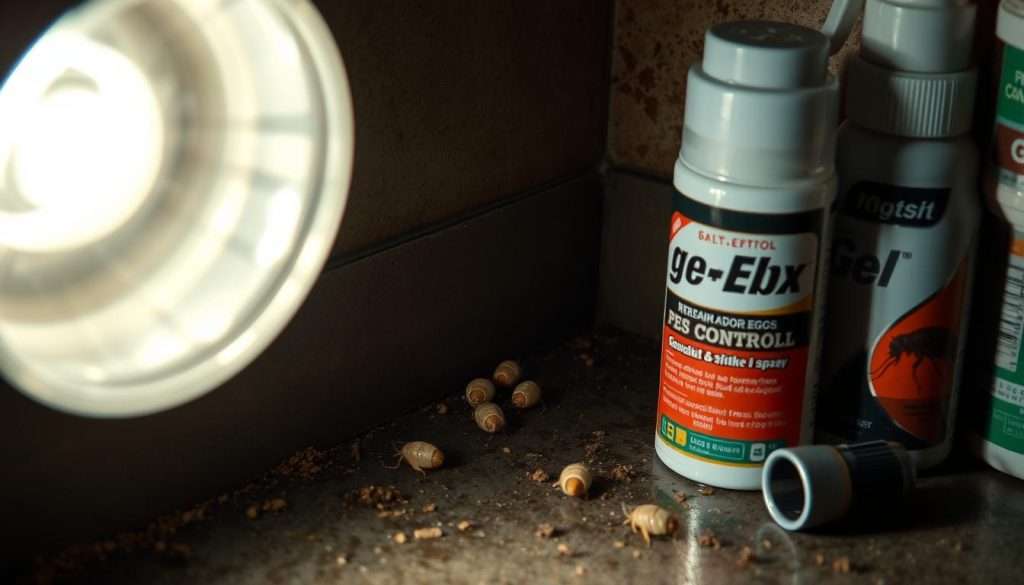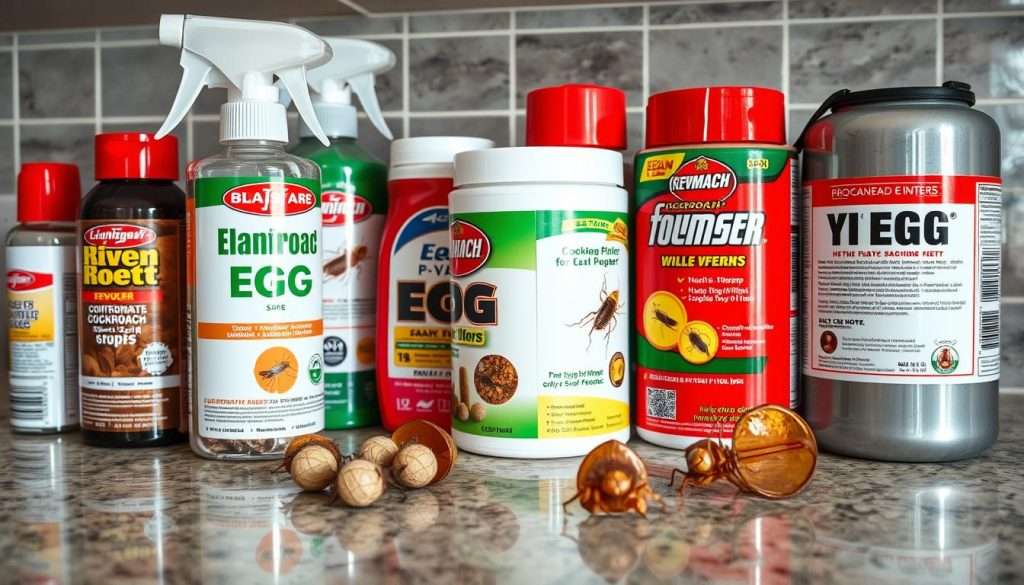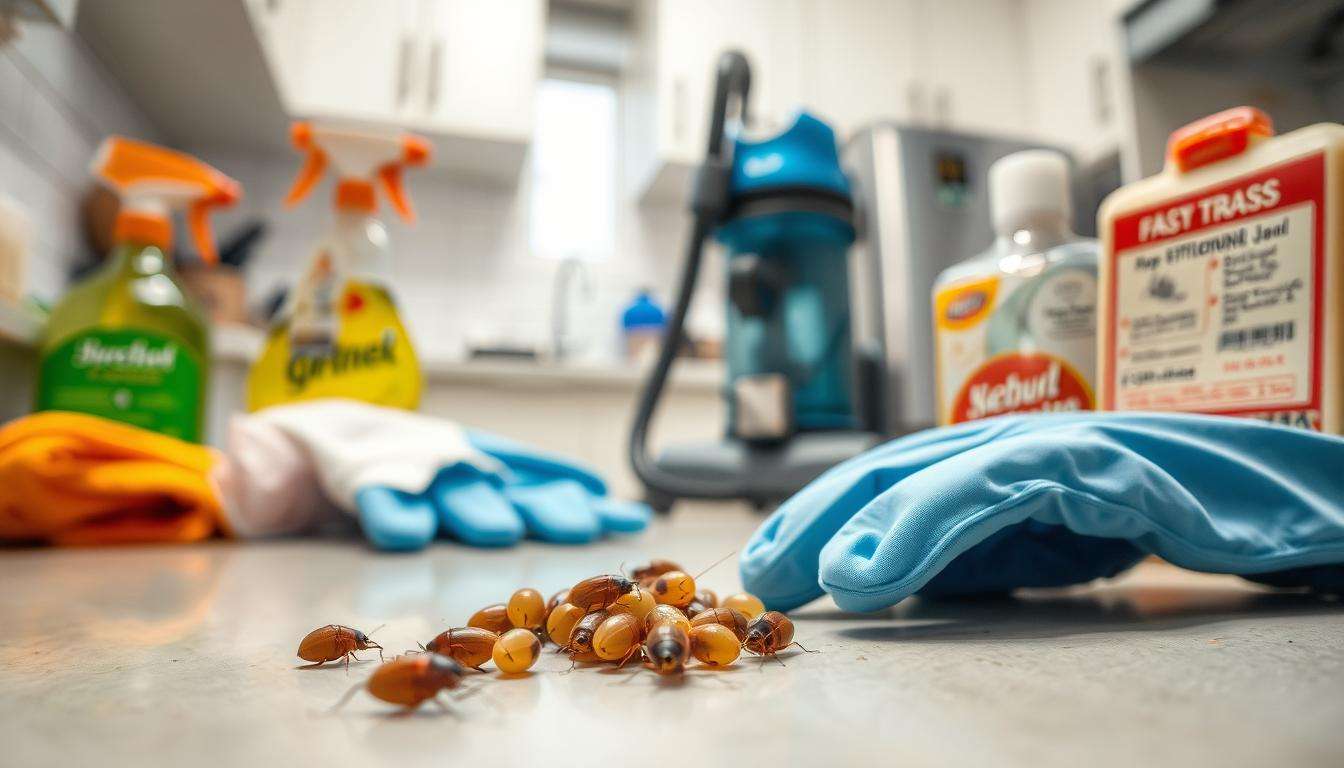Cockroach eggs, also known as ootheca, are a big problem in homes. A single female German cockroach can lay up to 300 eggs. This means you could have 30 to 40 nymphs from each egg.
These eggs can hatch in just 6 to 8 weeks. This leads to a fast increase in cockroach problems. In this guide, we’ll cover how to spot cockroach eggs and where they hide. We’ll also share effective ways to remove them.
Learning how to get rid of cockroach eggs is the first step to a safe home. It’s important to know the basics.
Key Takeaways
- Understanding ootheca is vital for effective cockroach control.
- A female German cockroach can lay hundreds of eggs.
- Eggs hatch quickly, underscoring the need for rapid removal.
- Identifying hiding spots is key to comprehensive pest management.
- Preventive measures can significantly reduce the likelihood of future infestations.
- Utilizing natural and chemical methods enhances cockroach egg removal.
Understanding Cockroach Eggs: What You Need to Know
Knowing about cockroach eggs is key to managing pests. Learning about oothecas helps you get rid of cockroach eggs. An ootheca is a protective case for cockroach eggs. It looks like a small, dark brown bean.
The size and color of these cases vary by species. For example, German or American cockroaches have different sizes and colors.
What is an Ootheca?
An ootheca is a capsule, about 1/4 to 1/2 inch long. It holds activated cockroach eggs. Each species has its own egg count:
| Species | Egg Count per Ootheca | Color |
|---|---|---|
| German Cockroach | 30-50 | Dark Brown |
| American Cockroach | 15-16 | Dark Brown |
| Brown-Banded Cockroach | 10-18 | Dark Brown |
| Oriental Cockroach | 16 | Dark Brown |
Identification of Cockroach Eggs
Spotting cockroach eggs is crucial for pest control. Look for dark brown, oval eggs, about a quarter to half an inch long. Female German cockroaches carry their egg cases.
Other species drop their oothecas in sheltered spots weeks before hatching. It’s important to find these spots in your home. Regular checks can stop infestations fast. One female German cockroach can lead to over 30,000 in a year.
For more info on cockroaches and their eggs, check this resource. Knowing how to get rid of cockroach eggs helps keep your place pest-free.
Finding Cockroach Egg Hiding Spots
Finding where cockroaches lay eggs is key to controlling them. Spotting them early helps stop small problems from getting big. Knowing where they like to hide and the signs of infestation helps prevent a big problem.
Common Areas Where Cockroaches Lay Eggs
Cockroaches like dark, warm, and moist places to lay eggs. They often hide in:
- Kitchens – Near food sources like cabinets and pantry areas
- Bathrooms – Behind sinks or in damp corners
- Behind appliances – Refrigerators, stoves, and microwaves
- Cupboards – Especially those that store food items
- Laundry areas – Often overlooked, providing ideal conditions
Signs of Cockroach Infestation
Spotting signs of cockroach infestation early helps control them. Look for:
- Droppings – Small dark pellets indicating activity
- Shed skins – Evidence of growing nymphs
- Oothecae – Egg cases, which can range in size from a few millimeters to over a centimeter in length
Regular checks in these spots can find potential nesting areas. Remember, finding one egg case means there’s a big problem. So, act fast.

How to Get Rid of Cockroach Eggs: Effective Techniques
Getting rid of cockroach eggs is key to stopping infestations. Two good ways are manual removal and using diatomaceous earth. Both methods help treat and eliminate cockroach eggs well.
Manual Removal of Ootheca
One easy way to get rid of cockroach eggs is to find and remove the ootheca. Here’s how:
- Wear gloves to protect your hands.
- Look for the ootheca in dark, moist spots.
- Use a vacuum or damp cloth to remove the egg cases.
- Throw away the ootheca right away to stop eggs from hatching.
It’s important to destroy the egg cases. One ootheca can have 16 to 48 eggs. German cockroaches can lay up to 30,000 eggs in a year. So, stopping their breeding is very important.
Using Diatomaceous Earth as a Natural Method
Diatomaceous earth is a safe and effective way to treat cockroach eggs. It works by drying out the eggs. Here’s how to use it:
- Spread food-grade diatomaceous earth in cockroach hiding spots.
- Put it in corners, under appliances, and along cupboard edges.
- Let it sit for a few days to disrupt cockroach breeding.
This method not only kills cockroach eggs but also lowers their numbers. By targeting the eggs, you can fight cockroach infestations better.
Chemical Methods for Cockroach Egg Elimination
Chemicals are key when cockroaches are a big problem. Knowing your options helps a lot in getting rid of cockroach eggs. There are two main types: Insect Growth Regulators (IGR) and residual pesticides.
Insect Growth Regulators (IGR)
Insect Growth Regulators stop cockroaches from growing. They mess with young cockroaches, stop them from growing, and can even stop eggs from hatching. IGRs are great for controlling cockroach numbers, especially in places where spray can’t reach all eggs.
- Safe for household use when applied correctly.
- Target immature roaches, ensuring fewer adults can reproduce.
- Can prevent future infestations by reducing egg viability.
Residual Pesticides for Egg Destruction
Residual pesticides are strong against cockroach eggs. They create a barrier that kills eggs and adult cockroaches. Always follow the instructions to use them safely and effectively.
| Type of Chemical | Functionality | Usage Precautions |
|---|---|---|
| Insect Growth Regulators | Disrupts life cycle, preventing hatching and reproduction | Use in well-ventilated areas; keep away from pets |
| Residual Pesticides | Kills eggs and adult cockroaches upon contact | Follow instructions; ensure surfaces dry after application |

Preventing Future Cockroach Infestations
Keeping your place pest-free is key. Cockroach control means clean living and smart habitat care. By taking steps now, you can keep cockroaches away for good.
Sanitation and Habitat Management
Good cleaning is the first step against cockroaches. Here’s how to make your home less inviting:
- Seal food in airtight containers to prevent access.
- Wipe down surfaces regularly to remove food particles.
- Clean kitchen appliances, including the inside of ovens and microwaves.
- Dispose of trash properly and frequently.
- Fix plumbing leaks and eliminate standing water to deny cockroaches a water source.
Don’t forget about habitat management. Seal cracks and crevices where cockroaches might hide. This makes your home less welcoming to them.
Exclusion Techniques to Keep Cockroaches Away
Block their entry points to control infestations. Here are some ways to do it:
- Install door sweeps to block gaps under doors.
- Cover vents with screens to prevent pest entry.
- Repair damaged window screens and seal unnecessary openings.
- Ensure that all exterior openings, such as utility lines, are securely closed.
By focusing on these steps, you can keep your home safe from cockroaches. Stay proactive to keep your home pest-free.
Conclusion
Knowing how to get rid of cockroach eggs is key to a pest-free home. Female cockroaches can lay dozens to hundreds of eggs. Finding their breeding spots and using effective removal methods can cut down infestations a lot.
Look for eggs in dark corners, moist spots, and cracks. These are where cockroaches like to lay their eggs. Using a vacuum, sealing cracks with caulk, or a homemade vinegar and water mix can help get rid of eggs without harsh chemicals.
Keeping your home clean, storing food right, and decluttering often also helps. These steps can stop cockroach eggs from spreading in your home.
With the right knowledge and actions, you can fight off cockroach infestations. You can choose natural methods or insect growth regulators. Each choice is important in your fight against these pests.
